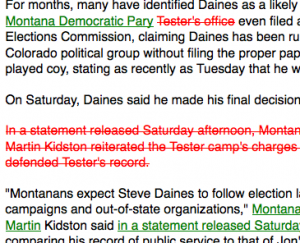
Yesterday, Missoulian editor Sherry Devlin posted to her blog on the subject of news corrections. In her post, Devlin gives us an excerpt from a MediaBugs article by Scott Rosenberg and Mark Follman, in which the two discuss best practices for newspapers that need to correct errors of fact.
The key point in Rosenberg and Follman’s article is that it needs to be easy for readers to submit corrections when needed, via a link near the text in question. That link should be clearly labeled and its purpose should be easy to understand. Further, the authors say that corrections should be displayed prominently and clearly noted.
All this talk of corrections inspired me to revisit how the Chronicle handles corrections, especially on our website. So I’ll walk you through what we do and then talk about why we do it that way.
First, someone reports a correction. As soon as we receive it, we check out the article — whether online or in print — to confirm that there is a problem. If the problem isn’t self-evident, we check with the reporter who wrote the article or the editors who worked on the article. The requisite research is done to fix the article, and a correction is written up for the print edition.
As soon as the text of a correction is filed, it’s ready to go online. We find the article on our website and find out what changes need to be made to the text of the article to correct it. All corrections are done in HTML, using the <ins> and <del> tags. Then we add an editor’s note at the top of the story to explain what was changed and when.
The printed edition of the correction appears in the next day’s paper on Page A2, where corrections are always printed. Also on that page is the paper’s masthead, which has information about how readers can report an error to the editors.
Now, I think that the print-edition side of that process is fairly self-explanatory, so I won’t address it here, other than to say that we have been moving away from an old newspaper maxim that says “don’t repeat the error.” Instead, we write clearly and succinctly what the error was and what it should have said instead. We feel it’s less confusing for our readers to do it this way.
As for online: In the old days, before we went live with our current website, corrections weren’t regularly posted online. That means that articles from mid-2009 and earlier could have errors that persist online. It’s a sad-but-true situation that isn’t likely to change. We can only promise to do better from now on.
Since I came onboard as Web Editor, I have made sure to post corrections online every time they are needed. The way I see it, errors in online stories have just as much or more potential to harm as the ones printed on paper because those online errors have a wider potential reach and are likely to be preserved longer and repeated more often.
Think of all those urban mythic horror stories you’ve heard about people losing jobs or failing to get jobs because incriminating (yet false) information about them was posted online when their employer did a Web search. Information’s persistence online is called the “long tail,” and it’s a newspaper’s job to make sure that long tail is as accurate as possible.
So, we make corrections online a priority, and we make those corrections in a way that’s traceable. We don’t hide the fact that the Chronicle got something wrong. When we need to “delete” erroneous text from a news article, we wrap that text in <del> tags. This makes the text on our site appear in red with a strikethrough. When we add text, we wrap it with <ins> tags, which makes it appear green with an underline. In this way, readers can clearly see what we have added and “removed” from a story.
Further, we add an editor’s note at the top of every article that has been changed that clearly explains how and when the article was changed. You can find a list of articles we’ve changed recently on our News index page or here. You can subscribe to an RSS feed of our corrections too.
We take corrections seriously, and we never let one go by without learning something about how it happened (or how we let it happen). I hope this gives you a little insight into how we handle them.
Oh, and if you need to report an error in the paper, call the Chronicle at 406-587-4491 or e-mail us at citydesk@dailychronicle.com.
Related articles
- MediaBugs: How US newspapers differ on corrections and clarifications (blogs.journalism.co.uk)
